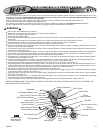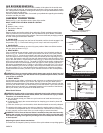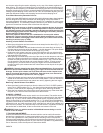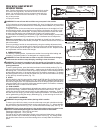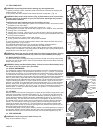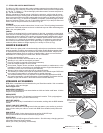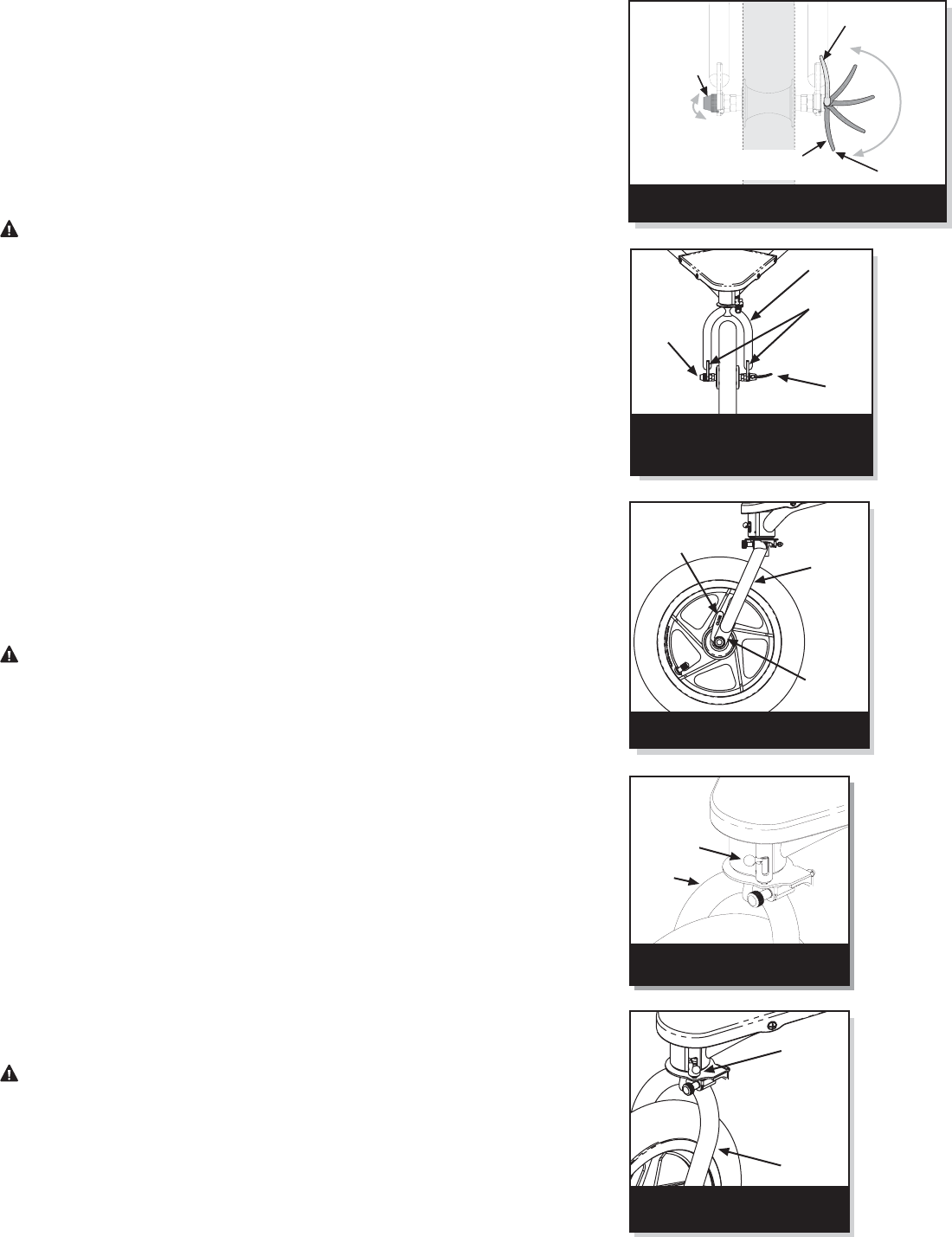
one dropout and pulling the tension adjusting nut, by way of the skewer, against the
other dropout. The amount of clamping force is controlled by the tension adjusting nut.
Turning the tension adjusting nut clockwise while keeping the cam lever from rotating
increases clamping force; turning it counterclockwise while keeping the cam lever from
rotating reduces clamping force. Less than half a turn of the tension adjusting nut can
make the difference between safe clamping force and unsafe clamping force.
Front Wheel Secondary Retention Devices
All 2007 and newer BOB Strollers have front forks which utilize secondary wheel retention
devices designed to help keep the wheel from disengaging if the quick release is
incorrectly adjusted. Secondary retention devices are not a substitute for correct quick
release adjustment. The secondary retention devices on your stroller are the integral
type that is formed into the outer faces of the front fork dropouts.
WARNING: Do not remove or disable secondary retention devices. As its name
implies, they serve as a back-up for a critical adjustment. If the quick release is
not adjusted correctly, the secondary retention devices can reduce the risk of the
wheel disengaging from the fork. Removing or disabling the secondary retention
devices may also void the warranty.
Secondary retention devices are not a substitute for correct quick release
adjustment. Failure to properly adjust the quick release mechanism can cause
the wheel to wobble or disengage, which could cause you to lose control and fall,
resulting in serious injury or death.
Installing a Quick Release Front Wheel:
a. Move the quick release cam lever so that it curves away from the wheel (Fig. 7). This
is the FULLY OPEN position.
b. Insert the wheel between the fork blades so that the axle seats firmly at the top of
the slots that are at the tips of the fork blades the fork dropouts. The quick release
cam lever should be on the left side of the stroller (Fig. 8 & 9).
c. Holding the quick release cam lever in the OPEN position with your right hand as
shown in Fig. 8, tighten the tension adjusting nut with your left hand until it is finger
tight against the fork dropout.
d. While pushing the wheel firmly to the top of the slots in the fork dropouts, and at the
same time centering the wheel rim in the fork, move the quick release cam lever
upwards and swing it into the FULLY CLOSED position (Fig. 7 & 9). The lever should
now be parallel to the fork blade and curved toward the wheel. To apply enough
clamping force, you should have to wrap your fingers around the fork blade for
leverage, and the quick release cam lever should leave a clear imprint in the palm
of your hand.
WARNING: Securely clamping the wheel takes considerable force. If you can fully
close the quick release without wrapping your fingers around the fork blade for
leverage, and the quick release cam lever does not leave a clear imprint in the
palm of your hand, the tension is insufficient. Open the lever; turn the tension
adjusting nut clockwise a quarter turn; then try again.
e. If the quick release cam lever cannot be pushed all the way to the fully closed position
parallel to the fork blade, return the lever to the OPEN position. Then turn the tension
adjusting nut counterclockwise one-quarter turn and try tightening the lever again.
Removing a Quick Release Front Wheel:
a. Move the wheels quick-release lever from the locked or FULLY CLOSED position
to the FULLY OPEN position (Fig. 7). Your front fork has integral secondary retention
devices. Loosen the tension adjusting nut enough to allow removing the wheel.
b. Raise the front wheel a few inches off the ground and tap the top of the wheel with
the palm of your hand to knock the wheel out of the front fork.
6. SWIVEL LOCKOUT:
The Revolution Duallie stroller can be used in one of two modes. The stroller can be
used as a swiveling wheel stroller (Walk Mode) when the Lockout Knob is in the unlocked
position (Fig. 10). Or, it can be used as a fixed wheel stroller (Jog Mode) when the
swivel Lockout Knob is in the locked position (Fig. 11). To change from Walk Mode to
Jog Mode, lift and slide the Lockout Knob (Fig. 10) up and all the way to the right. Then
release the knob, and it will snap down. Next, rotate the fork until the pin engages and
locks the fork in position. You are now ready to use the stroller in Jog Mode. To change
the stroller back to Walk Mode, lift the Lockout Knob and rotate it to the left.
WARNING: Never jog with the stroller in Walk Mode because doing so could
result in loss of control.
7. TRACKING ADJUSTMENT:
It should be noted that all fixed three wheeled vehicles can be easily influenced to
deviate from a straight path. In some cases strollers can have or develop a tendency
to pull to the right/left due to many different factors including uneven tire pressure,
improper wheel installation, road conditions and manufacturing tolerances. If you find
your BOB stroller to significantly track or pull to the left or right while in Jog Mode during
use on flat terrain, follow the sequence of instructions below.
Fig. 10 Swivel Lockout -
Unlocked Position (Walk Mode)
Swivel
Lockout
Knob
(Unlocked
Position)
Fork
Fig. 11 Swivel Lockout -
Locked Position (Jog Mode)
Swivel
Lockout
Knob
(Locked
Position)
Fork
P3OMS07A
Fig. 7 Front Wheel Quick Release Anatomy.
(rotate to
adjust
clamping
force)
FULLY
OPEN
FULLY
CLOSED
Tension
Adjusting
Nut
Quick Release
Cam Lever
Fig. 9 Quick Release in closed
position and parallel to fork blade.
Fork
Blade
Fork
Dropout
Quick
Release
Cam Lever
Closed
Fig. 8 Front fork dropouts shown
with wheel in position. Adjust nut snug
with Quick Release in OPEN position.
Fork
Blade
Fork
Dropouts
Quick
Release
Cam
Lever
Open
Tension
Adjusting
Nut



